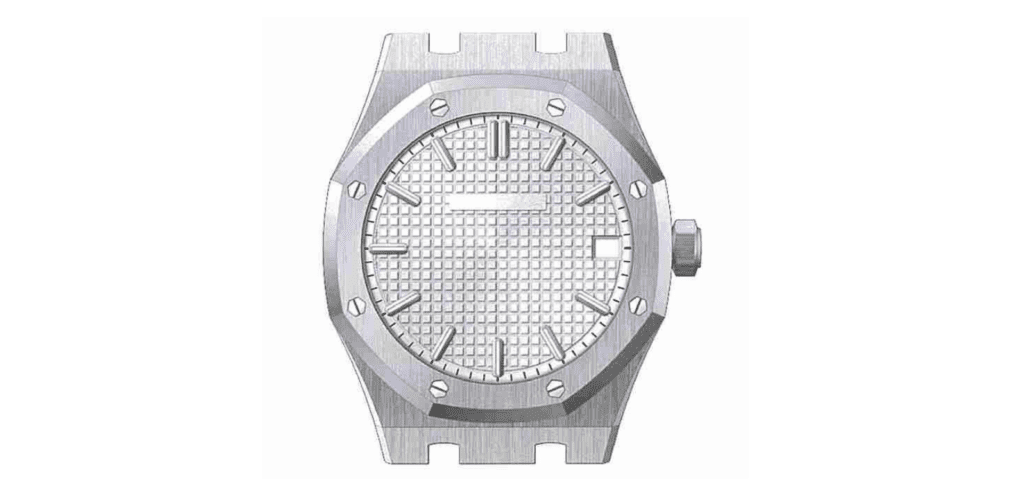A Japanese court dismissed an appeal from Audemars Piguet, finding that the Swiss watchmaker failed to show that the design of its coveted Royal Oak has acquired distinctiveness in the market. In a decision in late March, the Japanese IP High Court dismissed an appeal filed by Audemars Piguet Holding SA, which sought to overturn the Japanese Patent Office (“JPO”) and its Appeals Board’s earlier refusals to register a trademark that covers the octagonal face of the Royal Oak watch (for use on watches in Class 14) on the basis that the mark lacks inherent distinctiveness and the watchmaker failed to establish that the appearance of the watch design has acquired distinctiveness in the Japanese market.
On the heels of the JPO refusing to register the Audemars Piguet (“AP”) mark at issue, which consists of “a dial with a tapisserie pattern and hour markers, minute track, date window, an octagonal bezel with 8 hexagonal screws, case, a crown, and a lug of the famed ‘ROYAL OAK’ watch collections,” the Appeal Board affirmed the decision in June 2023. According to the Board, relevant consumers are not likely to view the AP mark as an indicator of a single source (and thus, a trademark), and instead, would view it as a generic shape of a wristwatch in light of the prevalence of similarly-shaped watches from other watch-making entities.

As such, the mark lacks inherent distinctiveness based on Article 3(1)(iii) of the Japan Trademark Law, and AP failed to produce sufficient evidence to show that the shape per se has acquired distinctiveness in the market (as required by Article 3(2)), the Board determined.
Unsatisfied with the outcome, AP lodged an appeal with the Japan IP High Court, as first reported by Marks IP, arguing that the trademark office should have green-lit its application for registration for the shape of the Royal Oak face for use on watches. And in a decision in March, the IP High Court handed AP yet another loss.
First focusing its attention on inherent distinctiveness, the court found that “there is no particular circumstance in which the shape represented by the applied [for] mark is novel” when compared to the shapes of other wristwatches. Even if the shape was “unique as a whole,” the court held that “the shape of each component is made in a form suitable for use as a wristwatch and selected from the viewpoint to achieve the function of the goods.” As such, the applied-for mark “remains within the scope of expected selection of the shape for functional reasons of a wristwatch, [and therefore], lacks distinctiveness.”
(In connection with the issue of distinctiveness, it is worth considering the extent to which other watches in the market make use of of the elements like the octagonal bezel, the placement of multiple screws, etc. due to the fact that they are looking to mirror the well-known design (and piggyback on the appeal) of the Royal Oak, a fact that would certainly weigh in AP’s favor.)

Turning to acquired distinctiveness, the court took issue with the evidence provided by AP, which established (in furtherance of its bid to show that the mark has amassed secondary meaning among relevant consumers) that it has been using the Royal Oak shape mark since 1977, has generated an average of JPY 8 billion ($51 million) in annual sales of Royal Oak watches in Japan in each of the past six years, and spends more than JPY 400 million ($2.6 million) on advertising that features the Royal Oak in Japan each year.
Unpersuaded by the figures provided by AP, the court stated that these sales and marketing figures fall short because they fail to take in account that AP sells multiple different watches under the Royal Oak name and that not all of them match the specific design at the heart of the applied for mark. As such, the sales and advertising figures may not accurately reflect consumers’ awareness of the applied-for mark. Moreover, the court pointed out that AP did not produce any consumer surveys that show that consumers do, in fact, view the shape mark as an indicator of source of the AP brand, which similarly weighed against a finding of acquired distinctiveness in the eyes of the court.
With the foregoing in mind, the court sided with the JPO on its inherent distinctiveness and acquired distinctiveness determinations and dismissed AP’s appeal.
THE BIGGER PICTURE: The loss for AP comes amid a string of unfavorable trademark-centric outcomes for western brands – whether that be Hermès’ failure to register its orange and brown product packaging or Moncler’s failure to stomp out the registration of a “lookalike” trademark for use across an array of similar goods/services.
Looking beyond these trademark trends, the losses for well-known brands come against the background of a surging luxury goods market in Japan, which “has remained a bright spot for top-end spending despite slowdown in many other markets” thanks to deep-pocketed tourists and a fall in the value of the yen, the FT reported late last year.













